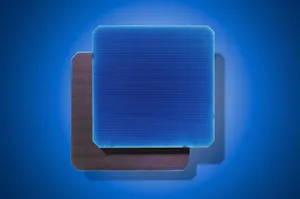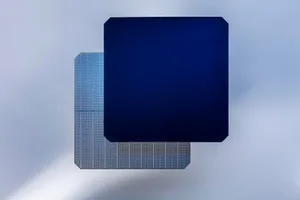
Technology development for silicon solar cells
ISFH develops highly efficient, cost-optimized and industry-oriented solar cells with the aim of contributing to the reindustrialization of PV production in Europe with these technology options. The development work takes place both in publicly funded joint projects and in bilateral cooperation.
The focus of our technology development is on solar cells with POLO contacts. We are pursuing variants with metal contacts on both sides as well as back-contact solar cells:
- PERC+ cells with an efficiency of 23.2 %
- POLO BJ cell with an efficiency of 24.2 % and halved Ag consumption
- POLO IBC cell with an efficiency of 24.1 % using a short fabrication process
- POLO² IBC cell with an efficiency of 26.1 % (5 cm x 5 cm)
We are currently processing silicon wafers of size M2 (15.6 cm edge length) at our SolarTeC technology center. From 2026, we will be using M10 silicon wafers (edge length 18.2 cm) with state-of-the-art industrial processing equipment.

POLO backjunction solar cells
Our POLO BJ solar cell uses p-type wafers, Al contacts on the (non-diffused) front side, an n+-type passivating poly-Si-on oxide (POLO) back contact and silver contacts on the back side. This enables up to 50 % less silver consumption compared to TOPCon or HJT solar cells.

POLO IBC solar cells (back contact)
Our interdigitated back contact (IBC) solar cells use passivating poly-Si-on oxide (POLO) contacts on the rear side. An IBC technology with p-type wafers and a local n+-type POLO contact is available as a cost-effective upgrade for PERC lines. We are also developing IBC solar cells with POLO contacts for both polarities.
TOPCon solar cells
TOPCon solar cells use n-type wafers, a boron diffusion on the front side and an n+-type passivating poly-Si-on oxide (POLO) back contact. This technology is already widely used commercially and serves as the baseline process at ISFH.
Publicly funded joint projects
APOLON
APOLON – Investor-oriented development of POLO technology for a PV production in Germany and Europe
ARTEMIS
POLO technology with less silver consumption for PV modules as a contribution to secure energy supply with less dependency on imports
OLIVIA
High-performance, cost-effective IBC solar cells for future PV production in Germany
IBC4EU
Piloting novel cost-competitive bifacial IBC technology for vertical integrated European GW scale PV production value chain
BURST
Breaking Limits Using Record Enabling Silicon Technology With Photonic Management